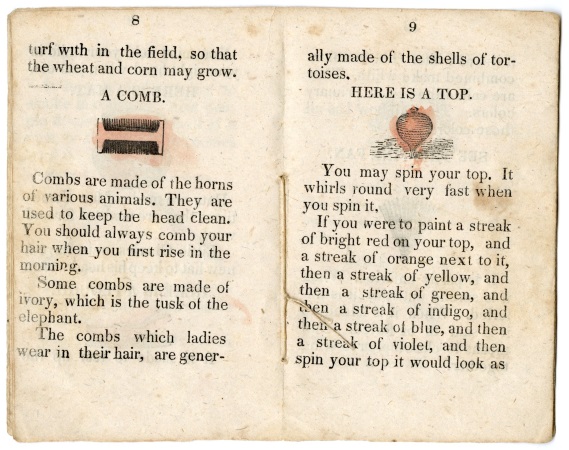Between 1820 and 1830, Burlington, Vermont experienced significant growth. The population increased dramatically, from 2111 in 1820 to 3526 in 1830, a 67% increase. Among the new residents who relocated from other Vermont communities were Jonathan Lamb (1795-1851), an educator and University of Vermont student, and Chauncey Goodrich (1798-1858), a bookseller and publisher.
Lamb taught at Burlington Academy, located at the corner of Willard and College Streets, from 1824-1829. He also attended UVM during those years, graduating in 1829. In July 1831, he opened a new school for “the purpose of instructing Young Gentlemen in the various branches of science and literature” and offered lectures on teaching for men who would be working in schools in the winter.
Lamb used his teaching experience to write several schoolbooks. Shortly after Goodrich set up shop in Burlington, an advertisement in the Nov. 7, 1828 Burlington Weekly Free Press announced that Lamb’s book, The Child’s Primer, or First Book for Use in Primary Schools, was in press and soon to be published. Lamb’s second volume, The Child’s Instructer, was published by A. & D. Day in 1829, but Goodrich published Lamb’s Gospel Sonnets, “designed principally for youth” in 1830. At the same time, Lamb wrote twelve small chapbooks that Goodrich offered as a series of Little Books for Children.

Silver Special Collections holds four of Lamb’s little books: The Shipwreck, The Lion and the Snake, A Present for a Good Boy, and A Present for a Little Cousin. The 2.5 x 4-inch books contain 16 pages and are illustrated with woodcuts. Only one retains its original paper wrapper. The printer used different tactics to fill all 16 pages, including double spacing lines and filling the last few pages with unrelated poems and stories.
Lamb’s little books were designed to be entertaining and educational. Lamb frequently addresses his “little readers” directly, offering advice and guidance about reading and behavior in a conversational tone. He describes the characteristics of animals and common objects, and uses the descriptions to teach moral lessons. When describing a chair, the author cautions, “You should not sprawl out your legs and lean your chair back in the company of ladies and gentlemen.” At the end of a story about lions, he warns children not to be unkind or impudent, or people will say “They are worse than beasts, for even lions love those who are kind to them, and feed them.”
 Pages from A Present for a little Cousin
Pages from A Present for a little Cousin
Lamb’s little books are similar to small children’s books published elsewhere, and sometimes include borrowed content. The Shipwreck is a poem published in numerous editions by the Religious Tract Society in London beginning in 1795 and by the American Tract Society in 1829. Lamb’s version is missing a number of verses, perhaps to allow it to fit into sixteen pages. In The Lion and the Snake, Lamb included stories about lions borrowed from Peter Parley’s popular Tales of Animals, which he highly recommends to his readers.
Goodrich sold the books at his shop in Burlington, but they were probably available at stores in other Vermont communities. In 1830, Goodrich advertised his new publications, including “12 different kinds of small books for children” by J. Lamb, in the Vermont Chronicle, a statewide newspaper. In a study of reading habits in southwestern Vermont during this period, William Gilmore found that children’s books were one of the most frequently purchased book types. Only three months after publishing the Little Books, Goodrich claimed he had already sold 20,000 copies. Our copy of A Present for a Little Cousin is dated 1841, just over a decade after it was first listed in the series, suggesting that sales continued to be strong enough to warrant reprinting.
Lamb left Burlington in 1833 to serve as the first principal of an academy for young ladies and gentlemen in Keeseville, New York. By the early 1840s, Lamb was settled in Ann Arbor, Michigan, where he operated a bookstore and was a strong advocate for public education. Versions of his spelling book and primers were published by a Boston publisher in 1842 and 1843.
Contributed by Prudence Doherty, Public Services Librarian


